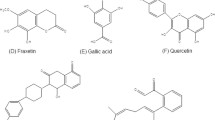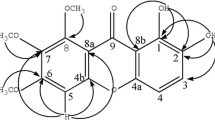Abstract
An ethanol extract of Helichrysum maracandicum showed antiproliferative activity against cultured cells of SENCAR mouse in an in vitro assay, and activity-guided fractionation of the extract resulted in the isolation of isosalipurposide as an active substance. Naringenin chalcone, the aglycone of isosalipurposide, also showed strong antiproliferative activity. An in vivo assay of two-stage carcinogenesis on mouse skin revealed that epidermal application of isosalipurposide resulted in delayed formation of papillomas. Western blot analysis showed that the expression of p38 mitogen-activated protein kinase was suppressed by the administration of naringenin chalcone or isosalipurposide, which might be related to the anticarcinogenic activity.



Similar content being viewed by others
References
Murakami A, Ohigashi H, Koshimizu K (1996) Anti-tumor promotion with food phytochemicals: a strategy for cancer chemoprevention. Biosci Biotechnol Biochem 60:1–8
Digiovanni J (1992) Multistage carcinogenesis in mouse skin. Pharmacol Ther 54:63–128
Bode AM, Dong Z (2000) Signal transduction pathways: targets for chemoprevention of skin cancer. Lancet Oncol 1:181–188
Suzgec S, Mericli AH, Houghton PJ, Cubukcu B (2005) Flavonoids of Helichrysum compactum and their antioxidant and antibacterial activity. Fitoterapia 76:269–272
Delapuerta R, Saenz MT, Garcia MD (1993) Choleretic effect of the essential oil from Helichrysum picardii Boiss and Reuter in rats. Phytother Res 7:376–377
Drewes SE, Mudau KE, Van Vuuren SF, Viljoen AM (2006) Antimicrobial monomeric and dimeric diterpenes from the leaves of Helichrysum tenax var tenax. Phytochemistry 67:716–722
Jakupovic J, Kuhnke J, Schuster A, Metwally MA, Bohlmann F (1986) Phloroglucinol derivatives and other constituents from South African Helichrysum species. Phytochemistry 25:1133–1142
Randriaminahy M, Proksch P, Witte L, Wray V (1992) Lipophilic phenolic constituents from Helichrysum species endemic to Madagascar. Z Naturforsch C 47:10–16
Meyer JJM, Afolayan AJ (1995) Antibacterial activity of Helichrysum aureonitens (Asteraceae). J Ethnopharmacol 47:109–111
Tepe B, Sokmen M, Akpulat HA, Sokmen A (2005) In vitro antioxidant activities of the methanol extracts of four Helichrysum species from Turkey. Food Chem 90:685–689
Jager AK, Hutchings A, vanStaden J (1996) Screening of Zulu medicinal plants for prostaglandin-synthesis inhibitors. J Ethnopharmacol 52:95–100
Musabayane CT, Munjeri O, Mdege ND (2003) Effects of Helichrysum ceres extracts on renal function and blood pressure in the rat. Ren Fail 25:5–14
Tokuda H, Ichiishi E, Onozuka M, Yamaguchi S, Konoshima T, Takasaki M, Nishino H (1998) The tumor initiating activity of NO donor. In: Moncada S, Tada N, Maeda H (eds) Biology of nitric oxide, part 6. Portland Press, London, pp 185–186
Zapesochnaya GG, Kurkin VA, Braslavskii VB, Filatova NV (2002) Phenolic compounds of Salix acutifolia bark. Chem Nat Comp 38:314–318
Le Bail JC, Pouget C, Fagnere C, Basly JP, Chulia AJ, Habrioux G (2001) Chalcones are potent inhibitors of aromatase and 17β-hydroxysteroid dehydrogenase activities. Life Sci 68:751–761
Kato R, Nakadate T, Yamamoto S, Sugimura T (1983) Inhibition of 12-O-tetradecanoylphorbol-13-acetate-induced tumor promotion and ornithine decarboxylase activity by quercetin: possible involvement of lipoxygenase inhibition. Carcinogenesis 4:1301–1305
Facino RM, Carini M, Franzoi L, Pirola O, Bosisio E (1990) Phytochemical characterization and radical scavenger activity of flavonoids from Helichrysum italicum G. Don (Compositae). Pharmacol Res 22:709–721
Calliste CA, Le Bail JC, Trouillas P, Pouget C, Habrioux G, Chulia AJ, Duroux JL (2001) Chalcones: structural requirements for antioxidant, estrogenic and antiproliferative activities. Anticancer Res 21:3949–3956
Mantena SK, Katiyar SK (2006) Grape seed proanthocyanidins inhibit UV-radiation-induced oxidative stress and activation of MAPK and NF-κB signaling in human epidermal keratinocytes. Free Radic Biol Med 40:1603–1614
Katiyar SK, Afaq F, Azizuddin K, Mukhtar H (2001) Inhibition of UVB-induced oxidative stress-mediated phosphorylation of mitogen-activated protein kinase signaling pathways in cultured human epidermal keratinocytes by green tea polyphenol (−)-epigallocatechin-3-gallate. Toxicol Appl Pharmacol 176:110–117
Chen WX, Tang QB, Gonzales MS, Bowden GT (2001) Role of p38 MAP kinases and ERK in mediating ultraviolet-B induced cyclooxygenase-2 gene expression in human keratinocytes. Oncogene 20:3921–3926
Subbaramaiah K, Dannenberg AJ (2003) Cyclooxygenase 2: a molecular target for cancer prevention and treatment. Trends Pharmacol Sci 24:96–102
Author information
Authors and Affiliations
Corresponding author
Rights and permissions
About this article
Cite this article
Yagura, T., Motomiya, T., Ito, M. et al. Anticarcinogenic compounds in the Uzbek medicinal plant, Helichrysum maracandicum . J Nat Med 62, 174–178 (2008). https://doi.org/10.1007/s11418-007-0223-y
Received:
Accepted:
Published:
Issue Date:
DOI: https://doi.org/10.1007/s11418-007-0223-y




